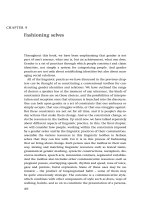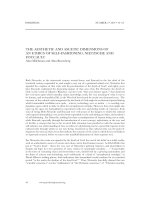Fashioning selves
Bạn đang xem bản rút gọn của tài liệu. Xem và tải ngay bản đầy đủ của tài liệu tại đây (213.78 KB, 28 trang )
CHAPTER 9
Fashioning selves
Throughout this book, we have been emphasizing that gender is not
part of one’s essence, what one is, but an achievement, what one does.
Gender is a set of practices through which people construct and claim
identities, not simply a system for categorizing people. And gender
practices are not only about establishing identities but also about man-
aging social relations.
All of the linguistic practices we have discussed in the previous chap-
ters can be thought of as constituting a conventional toolbox for con-
structing gender identities and relations. We have outlined the range
of choices a speaker has at the moment of any utterance, the kinds of
constraints there are on those choices, and the possibilities of interpre-
tation and reception once that utterance is launched into the discourse.
One can look upon gender as a set of constraints that one embraces or
simply accepts, that one struggles within, or that one struggles against.
But these constraints are not set for all time, and it is people’s day-to-
day actions that make them change. And as the constraints change, so
do the resources in the toolbox. Up until now, we have talked separately
about different aspects of linguistic practice. In this, the final chapter,
we will consider how people, working within the constraints imposed
by a gender order and by the linguistic practices of their communities,
assemble the various resources in this linguistic toolbox to fashion
selves that they can live with. For it is in this process of fashioning
that we bring about change. Each person uses the toolbox in their own
way, mixing and matching linguistic resources such as lexical items,
grammatical gender marking, syntactic constructions, metaphors, dis-
course markers, speech acts, intonation contours, segmental variables.
And the toolbox also includes other communicative resources such as
pregnant pauses, overlapping speech, rhythm and speed, tone of voice,
gaze and posture, facial expression. Some of these uses may be au-
tomatic -- the product of long-ingrained habit -- some of them may
be quite consciously strategic. The outcome is a communicative style,
which combines with other components of style such as dress, ways of
walking, hairdo, and so on to constitute the presentation of a persona,
305
306 Language and Gender
a self. This presentation may place the individual squarely within a
well-known category, or it may constitute a claim to a somewhat novel
identity. Communicative style is sometimes thought of as the external
wrapping inside which the meaningful substance is found, the how it
is said as distinct from what is said. But this picture is profoundly mis-
leading. What and how are inextricably linked, and the styles people
develop have as much to do with what they (typically) say and do as
with how they say it. Elite young women in the American south being
prepared for cotillions that present them to society are still receiving
instruction on table manners, makeup, posture and carriage, and not
only how to speak but what to speak about (avoid religion and politics,
they are told). And although there isn’t overt instruction in how to talk
or what to say, members of men’s varsity teams at elite universities of-
ten adopt a ‘‘locker-room’’ style that includes not only lots of profanity
but also ways of talking disparagingly about women and about other
men who don’t measure up to certain norms of masculinity. Style com-
bines what we do and how we do it. It is not a fa
ç
ade behind which
the ‘‘real’’ self stands but it is the manif
estation of a self we present
to
the world.
Aperson’s style is not static -- it emerges in social practice, and in-
volves an ongoing history
of stylistic moves. The first time a girl puts on
eyeliner, the
first time a boy adds some flair to his basketball toss may
be momentous moves for them.
Each time they repeat these
moves,
they become increasingly part of their style, part of a claimed persona.
And a given individual may develop alternative styles, presenting dif-
ferent personae in different communities of practice. Amale athlete
who presents a somewhat misogynistic and homophobic persona to
his teammates may present quite a different persona in the orches-
tra in which he also participates. In the earlier chapters, we spoke of
moves primarily with respect to advancing personal agendas as rela-
tionships unfolded. Here we will focus on stylistic moves, which are
indeed made with respect to our personal agendas and relationships,
but which also carve out new
social possibilities for the kinds of per-
sonae that we present, and for the kinds of personae that can inhabit
our communities.
Stylistic practice
Our place in the gender order constrains our acts, but at the same time
it is our acts (and those of others) that place us in the gender order
and that bring the different aspects of gender into being. While social
307 Fashioning selves
structure and available resources provide constraints, it is people who
decide just how constrained they will allow themselves to be. And these
decisions are not made simply with reference to gender, but with refer-
ence to all the other aspects of our being that interact -- often unknown
to us -- with gender. For example, the prescriptive norm against females’
use of profanity is constantly invoked, often obeyed, but at least as of-
ten ‘‘broken.’’ And when it is broken, a rebuke may take the form of
a gender-based admonishment, such as ‘‘that’s not ladylike!’’ But the
decision to use profanity is more likely to be on the level of whether
one wants to be ‘‘nice’’ or not, whether one is sufficiently provoked, or
whether one wants to be cool, modern, in-your-face, etc. Furthermore,
the decision is not necessarily made at the level of ‘‘shall I start us-
ing lots of profanity?’’ -- but interaction by interaction, in a particular
situation, as one decides at that moment to use some profanity. And
with each choice to swear or not to swear, the next choice is weighted
by one’s experience with the previous one -- how was it received? How
did one feel afterwards? Often, perhaps even usually, there is not the
kind of self-conscious deliberation involved that the word choice seems
to suggest, but the important point is that people speak in certain
ways rather than others for reasons even though they may be unable
to articulate those reasons. Over time patterns will emerge (and the
decision process is likely to become more and more automatic), and
the use (or nonuse) of profanity in certain situations becomes part of
a person’s style.
Such decisions are not made in a vacuum, but always with refer-
ence to, and collaboratively within, our communities of practice. The
early adolescent girl who starts inserting profanity into her discourse
does so with respect to those she interacts with. She may be showing
autonomy from her teachers or other adults who are the main norm
enforcers for her age group, or perhaps distinguishing herself from her
more ‘‘goody-goody’’ peers. Or she may be showing affiliation with her
mother who swears, or her friends who swear. She may see swearing
as grown-up, as rebellious, as assertive, as angry, as autonomous, as
roustabout, or as a combination of these and other things. Maybe she
and her friends are beginning to fashion themselves as tough or maybe
she is pulling away from her friends and moving towards some tougher
people. Whatever the local dynamics, she is modifying her persona,
however slightly, and placing herself slightly differently with respect
to her communities of practice and the rest of the world. And depend-
ing on what those modifications are, she may or may not be changing
other things about herself -- possibly other parts of her language use.
For example if she is trying to get rebellious or tough, she may be using
308 Language and Gender
more nonstandard grammar as well. She may be adopting threatening
tags, or uttering threats. She may be changing the way she dresses, the
way she moves, the places she hangs out, the way she does her hair, the
things she talks about. In other words, she is changing her style.And
the style she develops may be exactly like some existing style, or it may
be slightly different. She may add her own twist. As she does this, she
is not just making a personal move, but changing the balance of social
meaning in her communities of practice, and ultimately in her school
and so on. One more girl who swears is one more drop in the gender
bucket, and one little modification of style puts a slightly new meaning
out into the discourse. Thus what is a momentary interactional move
for one girl can become part of a more long-term stylistic move. And
this, in turn, makes a slight change in the stylistic landscape that this
individual girl participates in. And enough similar stylistic moves will
carry potential for societal change as girls are more inclined to use pro-
fanity, and as they carry their profanity into adulthood. Perhaps with
greater use the profanity will lose some of its power; but at the same
time, girls will move one step away from constraints of delicacy and
niceness.
When we talk about style, we are talking about a process that con-
nects combinations of elements of behavior with social meaning. If a
girl takes up swearing, the swearing itself does not constitute a style,
but it combines with all the other things she does to constitute a style.
Depending on the resources she combines with her swearing, she may
project a style that’s slutty or tough, quirky, preppy but ‘‘different,’’ free-
thinking intellectual, etc. The reader might stop to think about how
combinations of grammar, lexicon, intonation, voice quality, segmen-
tal phonology, discourse markers and speech act types -- for example --
would combine with swearing to constitute quite different personae. It
is these personae, whole stylistic packages, that change social meaning
and reconfigure the social landscape, not the swearing by itself.
People are continually engaging in stylistic practice. Every act is by
definition a stylistic act, and our continual invention of ourselves is
a continual stylistic enterprise. Dick Hebdige (1984) presents style as
a process of bricolage. People take already available elements and com-
bine them to make something new. Our understanding of the social
world is based in, and facilitated by, a stylistic landscape. We recognize
landmarks in that landscape such as Valley Girl, Orthodox Jewish Male,
Suit, Teeny-Bopper, Zoot Suiter, Sloanie, Flapper, Punk, Hood, Cholo. Some of
these are located regionally, all are located socially, and all are located
in time. All of them invoke some place in social-stylistic time-space,
and all of them are composed of many elements. It is the multiplicity
309 Fashioning selves
of elements that allows for variation among different people orienting,
self-consciously or not, towards a common stylistic landmark. And as
we will see, the multiplicity of elements also makes it possible to popu-
late the stylistic landscape with socially significant new configurations,
producing new landmarks. In chapter eight, we discussed the shift
from Hungarian to German in Oberwart, Austria, and young women’s
move away from the peasant lifestyle. Hungarian and German were
stylistic resources for these women -- and each language choice went
no doubt with a way of dressing, of behaving, of doing their hair. The
choice was not simply between speaking in Hungarian and speaking
in German, but between being rural women and being townies.
The difference in use of linguistic variables by jocks and burnouts,
as discussed in chapter eight, is only a small part of the stylistic work
that goes into the creation of difference between the two mutually
opposed categories. Jocks and burnouts have distinct territories -- the
jocks hang out at lunchtime in the cafeteria hall, where they sell tick-
ets to events and hold sales of various sorts, while the burnouts hang
out in the school smoking area. They wear different clothing. In the
early eighties when this study was done, the jocks wore preppy clothes
in pastel colors with straight-legged jeans, while the burnouts wore
dark colors, rock concert tee shirts and bell-bottom jeans. They had
different hairstyles -- the burnouts (male and female alike) had long
hair, and the girls wore their hair straight; the jock boys and some
of the jock girls had short hair, while the jock girls with long hair
wore it in a ‘‘feathered’’ style. The girls wore different makeup -- the
jocks wore pastel colors, while the burnouts wore dark eye makeup.
The burnouts flaunted the use of controlled substances (particularly
cigarettes) while the jocks participated in antismoking activities in the
school. The burnouts wore urban symbols such as wallet chains and
Detroit or auto plant jackets, while jocks wore school symbols such
as varsity and school jackets and sweaters. They listened to different
music, went to different places, did different things. The symbolic dif-
ferences were endless, and almost every component of these two styles
was viewed as directly related to the core meaning of being a jock or
a burnout. And each side viewing the other interpreted the display of
any element of the other’s style as a direct expression of that core.
These two communities of practice, defining the social extremes of
the school, represented stylistic landmarks for the rest of the school.
(This is not to say that the jocks and the burnouts were the source
of stylistic elements, but that their use of these elements lent promi-
nence and visibility to them.) The many people who considered them-
selves ‘‘in-between” often mixed elements from jock and burnout style
310 Language and Gender
to indicate exactly where in the continuum between the two poles
they placed themselves. One symbol in particular -- the width of jeans
legs -- was especially iconic. The wider the bell, the more burned-out a
message the wearer sent.
Asimilar iconicity was visible in the makeup worn by the Chicana
gang girls that Norma Mendoza-Denton (1996) studied. One crucial
feature of the gang look was long eyeliner, which is taken to signal
the intention and willingness to fight. This kind of symbolism reaches
into action, since a girl with long eyeliner is not only expected to be
tougher -- she is more likely to be called on to fight. As one girl put it:
‘‘When I wear my eyeliner, me siento mas macha (I feel more macha),
I’m ready to fight.”Mendoza-Denton (forthcoming) emphasizes the com-
bination of such things as hair, lipstick, eyeliner, and clothing in cre-
ating a ‘‘look’’ -- and the combination of this look with an interactive
style -- as described by one gang girl:
Think about all the shit.
You’re hard.
Nobody could fuck with you,
you got power.
People look at you,
but nobody fucks with you.
So when you walk down the street,
you got the special walk, [begins to walk deliberately,
swinging her upper body]
you walk like this,
you walk all slow,
just checking it out.
I look like a dude,
¿
que no? (‘don’t I?’)
I walk, and then I stop.
I go like this [tilts head back -- this is called looking ‘‘in”]
I always look in, I always look in,
I never look down.
It’s all about power.
You never fucking smile.
Fucking never smile.
We never wear earrings,
just in case we get in a fight.
It’s not our style to wear earrings,
¿
me entiendes? (‘you know?’)
Don’t ever smile.
That’s the weak spot.
Don’t ever smile.
311 Fashioning selves
While the style does its work as a whole, its meaning draws on the
meanings of its elements. And it is in the creative use of these ele-
ments that we modify old styles, and create new ones. An example of
this process was described by two white high-school girls in northern
California in 1985 (Eckert 2000, p. 214). These two best friends were
part of a preppy crowd in their school, but they prided themselves on
being a little more open-minded and daring, a little less willing to be
dominated by the ‘‘school thing’’ than their friends. They symbolized
this by modifying specific elements of their clothing to show a small
similarity to another place in the local social landscape -- the new-wave
crowd in the high school, whom these two girls considered to be de-
sirably independent, but a bit too far out. The prominent style then
current among the new wavers featured black pegged pants. Clothing
color is an important stylistic element in this school -- indeed among
adolescents in general, and adults as well. The dark eye makeup and
clothing of the new wavers is quite commonly associated with ‘‘fast’’
sophistication, whereas the preppies’ pastels are commonly associated
with a clean-cut image. To adopt the dark colors of the new wavers
would have been too strong a stylistic statement, because ‘‘nice girls’’
don’t wear black. What these two girls adopted was the distinctive cut
of the pegged pants: they pegged their blue jeans. They were able to ar-
ticulate that this stylistic move placed them exactly where they wanted
to be in the local social-stylistic map. And to the extent that these par-
ticular girls were moving a bit towards the ‘‘daring’’ new wavers, they
were redefining what it means to be a preppy (and a new wave) girl
and any other kind of girl (and non-girl). They were making a ripple in
the landscape.
In such ways, people interpret the stylistic landscape and attribute
meaning to stylistic elements by contrasting a variety of styles; and
they build modifications and new styles through the creative segmen-
tation, appropriation, and recombination of these elements. In the pro-
cess, they make social meaning. This process is relatively apparent in
clothing, but it also takes place in language, and linguistic styles are
commonly part of larger styles that include clothing. In this way, peo-
ple construct selves in a process that is deeply embedded in the social
world, and this process of construction constructs the world itself. One
person’s stylistic move enters into the larger discourses of gender, race,
ethnicity, class, age, body type, and so on. In theory, no stylistic move
leaves anything unchanged. At the same time, no stylistic move comes
out of nowhere. If convention is a resource in this activity, it is also
a constraint, as the value of a stylistic move depends on its compre-
hensibility to others -- just as a stylistic move must be creative, it must
312 Language and Gender
also be recognizable. Styles cannot start with all new material, but owe
their success to the fact that they are based on elements that have been
used before, over and over again. This is what Jacques Derrida (1991)
refers to as iterability. The significance of pegged blue jeans relies on
the already existing significance of jeans, of black clothing, of pegged
pants. It also relies on the place of the preppy girls and the new wavers
in the local social order -- for much of the meaning of this move would
be lost if it were made, for instance, by a stoner (the local equivalent
of a burnout) or by a teacher.
Qing Zhang has illustrated the importance of the history of stylistic
elements in their contribution to meaning. In chapter eight, we dis-
cussed Zhang’s study (2001) of Beijing business managers, comparing
the language of men and women in state-owned and foreign-owned
businesses. In that discussion, we focused on the way in which men’s
and women’s job trajectories affected their use of linguistic variables.
Here we will return to Zhang’s work, but with a slightly different empha-
sis. With China’s entrance into the global capitalist market in recent
years, there has emerged a new social category of young people work-
ing in foreign financial enterprises. These people, who are embracing
a new level of materialism and consumption in a society that has been
materially egalitarian for several generations, are commonly referred
to as ‘‘Chinese yuppies.’’ The conditions in which the yuppies work are
radically different from those of their peers in traditional state-owned
businesses. While the state-owned businesses emphasize functionality
in both decor and dress, the yuppies’ business headquarters are ele-
gant, and the yuppies are expected to display a similar kind of global
elegance on their persons. Thanks to considerable salaries, the yuppies
pursue an elegant cosmopolitan lifestyle, introducing a completely new
way of life to the mainland. Along with the rest of their style, which
includes clothing, home decor, electronics, and leisure activities, their
language is changing to conform to their global personae. Specifically,
the yuppies are moving away from features that are typical of Beijing
speech, developing a more ‘‘cosmopolitan’’ speech style in contrast with
the quite local Beijing style of managers in state-owned businesses. In
constructing new styles, the yuppies draw on age-old and almost mythi-
cal types that can be found in literature as well as in everyday parlance.
One of these types is a classic Beijing male, the ‘‘smooth talker’’ -- a sur-
vivor, a glib character who can talk anybody into anything. Beijingers
commonly associate with this style a phonological variable that is char-
acteristic of the Beijing dialect of Mandarin. This variable, a rhotaciza-
tion of intervocalic fricatives and of syllable-final vowels, amounts to
putting an /r/ at the end of the syllable -- a sound that Beijingers hear
313 Fashioning selves
Table 9.1. Use of Beijing rhotacization (input = .699 ,p= .000 )
Female state
Female yuppies Male yuppies managers Male state managers
.105 .457 .737 .699
as giving a kind of rolling, ‘‘smooth’’ quality to speech. As shown in
Table 9.1,
1
Zhang found that this feature is common in the speech of
both men and women in the state-owned business, that male yuppies
retain this local feature in their speech to some extent, and that female
yuppies avoid it. As we can see, the female yuppies’ speech is not en-
tirely devoid of rhotacization, but almost. The male yuppies’ moderate
use of rhotacization appears to yield a style that is ‘‘toned down,” but
that nevertheless carries some smooth-talker flavor.
Zhang argues that while the smooth-talker image may add to a high-
flying businessman’s image, it would be risky for a woman with global
aspirations to try to make it in the same way. This brings us back to
the fact that we cannot simply compare males and females in simi-
lar positions, since the two are constrained to perform very differently
in those positions. Ayuppie businesswoman may have to be smooth,
but there is a certain trickiness and aggressiveness about a wheeling-
and-dealing smooth talker that is still judged ‘‘inappropriate’’ in a
woman.
Zhang also found that both male and female yuppies are adopting a
tone feature from non-mainland dialects of Chinese as spoken in Hong
Kong, Taiwan, and Singapore -- the Chinese-speaking regions that
dominate in the global market. In Beijing Chinese, unstressed syllables
lose their distinctive tone, becoming ‘‘neutral,’’ while in non-mainland
dialects, the syllables are more stressed and retain their own tone. This
tone feature gives the non-mainland dialects a staccato quality, and the
adoption of this feature into Mainland Mandarin has a similar effect.
While both male and
female yuppies are using this tone feature, which
is overwhelmingly associated with the global
market, the women use
it considerably more than the men. Zhang notes that the female yup-
pies in general sound more careful and articulate than the men, due
primarily to their avoidance of rhotacization and a few other variables
1 The numbers in this table represent the output of Goldvarb, a linear regression
program for the measure of constraints on linguistic variability. The input value is the
overall average rate of rhotacization (i.e., about 70%) for all of the speakers. The
numbers in the table itself represent the degree to which each group of speakers show
more (if the value is over .500) or less (if the value is under .500) than the input value.
314 Language and Gender
that contribute to this sound (and that show similar distributions) and
their use of the non-mainland tone feature. This meticulous-sounding
style, according to Zhang, enhances their overall image as competent
businesswomen. Partially explaining women’s care to construct a metic-
ulous global speech style is the fact that men and women have very
different career trajectories in the foreign financial sector, which im-
pose different kinds of language use as they build careers. As we men-
tioned in chapter eight, the women served as part of the business’s
global symbolic capital, and presumably their desire to be recognized
for their technical knowledge as well constrained them to use as global
a variety as possible. Note that the Beijing yuppies’ stylistic work is part
of a major social change, as they made selective use of local and non-
local features to construct particular gendered personae that moved
them into a new social niche. And the effect of their use of these fea-
tures built on the history of the features and the social types they had
come to be associated with.
The history of a linguistic resource can be cross-linguistic as well.
We mentioned above the importance of makeup to the Chicana gang
girl style that Norma Mendoza-Denton has studied (forthcoming). A
prominent linguistic resource that enters into this style is the pronun-
ciation of /i/ as in thing -- Chicano English includes a raised (i.e., higher
in the mouth) pronunciation of this vowel that matches the Spanish
pronunciation, as in seep rather than the English pronunciation as in
sip. While this feature clearly emerged as a result of Spanish--English
bilingualism, it is no longer a ‘‘foreign” feature, but an integral part of
a native English dialect that indexes Chicano identity. Different groups
of girls show quite different uses of this feature. Members of the two
rival gangs, the Norte
˜
nas and the Sure
˜
nas, use the raised pronunci-
ation 43 percent and 42 percent of the time respectively. Chicanas
who are engaged in school, on the other hand -- the jocks -- use it only
18 percent of the time. But in addition, this feature is most pronounced
when it appears in and everything. This is a common stylistic element
in Chicana speech, and Mendoza-Denton argues that it serves to invoke
in-group implications. For example in a gang girl’s discussion of how
girls from different gangs look at each other in order to pick a fight
(Mendoza-Denton 1995, p. 120):
Well I guess it depends on the person because one person will look at
you and everything, but they’ll kind of be scared at the same time. Cause
they’ll probably say, oh, look at her and everything, and if the girl turns
back and everything they could either back down or back up, and go, ‘‘hey,
what’s on,’’ you know? Then she can look at you up and down and
everything, you know, go around you know?
315 Fashioning selves
Mendoza-Denton points out that in these uses, and everything refers
to actions and scenarios that only an insider could fill in -- one has
to be familiar with gang confrontations to know what else happens
besides saying ‘‘look at her,’’ turning back, and looking someone up
and down. Thus the vowel itself takes on increased symbolic value as
it participates in a larger stylistic structure.
Stylistic resources can be appropriated from different genres as well.
In an analysis of sports talk shows, Daniel Lefkowitz (1996) has shown
how the hosts of these shows construct a hypermasculine style through
the appropriation of the intonation patterns of play-by-play sports an-
nouncing. In play-by-play speech, announcers maintain high pitch dur-
ing long stretches with only occasional -- but dramatic -- drops in pitch.
Lefkowitz argues that this maintenance of high pitch in fast-paced talk
conveys a quality of ‘‘liveness” -- a quality that the male sports-show
hosts achieve by the same means in their talk with callers.
Inasmuch as people feel that their way of speaking defines them,
the development of linguistic style is a central part of identity work.
Style is about creating distinctions (Irvine 2001), and how people talk
expresses their affiliations with some and their distancing from others.
It expresses their embrace of certain social practices and their rejec-
tion of others -- their claim to membership (and to particular forms
of membership) in certain communities of practice and not in oth-
ers. And within communities of practice, the continual modification
of common ways of speaking provides a touchstone for the process
of construction of forms of group identity -- of the meaning of be-
longing to a group (as a certain kind of member). Stylistic practice is
a resource for the orientation of the community and its participants
to other nearby communities and to the larger society, a resource for
constructing community members’ relation to power structures, locally
and more globally.
Style and performativity
What we are referring to as stylistic practice is at the crux of gender
performativity, a notion we discussed briefly in chapter four. Judith
Butler argues (1990, p. 25) that gender is ‘‘constituting the identity it
is purported to be. In this sense, gender is always a doing, though not
a doing by a subject who might be said to preexist the deed. . . There is
no gender identity behind the expressions of gender; that identity is
performatively constituted by the very ‘expressions’ that are said to
be its results.’’ Butler is arguing against the notion of a ‘‘core’’ self, a









